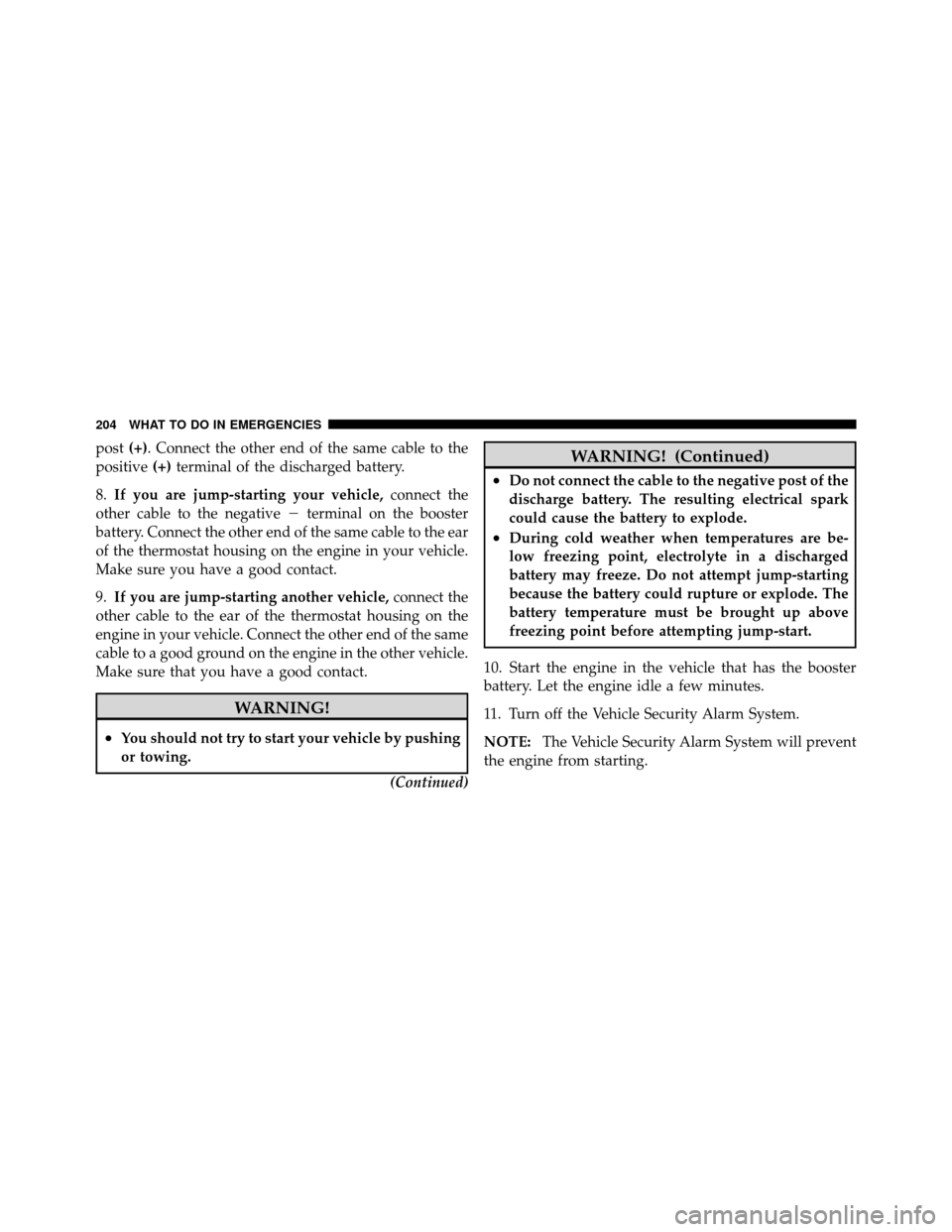Page 151 of 315

WARNING! (Continued)
•Do not attempt to push or tow your vehicle to get
it started. Unburned fuel could enter the catalytic
converter and once the engine has started, ignite
and damage the converter and vehicle. If the
vehicle has a discharged battery, booster cables
may be used to obtain a start from a booster
battery or the battery in another vehicle. This type
of start can be dangerous if done improperly, so
follow this procedure carefully. Refer to “Jump
Starting” in “What To Do In Emergencies” for
further information.
If the engine is flooded, it may start to run, but not have
enough power to continue running when the ENGINE
START button is released. If this occurs, continue crank-
ing up to 15 seconds with the accelerator pedal pushed all the way to the floor. Release the accelerator pedal and
the ENGINE START button once the engine is running
smoothly.
If the engine shows no sign of starting after two 15 sec-
ond periods of cranking with the accelerator pedal held
to the floor, the “Normal Starting” procedure should be
repeated.
After Starting
The idle speed will automatically decrease as the engine
warms up.
MANUAL TRANSMISSION
NOTE:
The parking brake should be engaged and the
shift lever placed into REVERSE before leaving the
vehicle, especially when parked on an incline.
5
STARTING AND OPERATING 147
Page 206 of 315

JUMP-STARTING PROCEDURES
WARNING!
•Take care to avoid the radiator cooling fans when-
ever the hood is raised. They can start anytime the
ignition switch is on. You can be hurt by the fans.
•Take care to avoid the accessory drive whenever
the hood is raised. You can be hurt by the moving
components.
•Do not attempt to push or tow your vehicle to get
it started. Unburned fuel could enter the catalytic
converter and once the engine has started, ignite
and damage the converter and vehicle. If the
vehicle has a discharged battery, booster cables
may be used to obtain a start from a booster
battery or the battery in another vehicle. This type
of start can be dangerous if done improperly, so
follow this procedure carefully.(Continued)
WARNING! (Continued)
•Battery fluid is a corrosive acid solution; do not
allow battery fluid to contact eyes, skin, or cloth-
ing. Do not lean over a battery when attaching
clamps or allow the clamps to touch each other. If
acid splashes in eyes or on skin, flush contami-
nated area immediately with large quantities of
water.
•A battery generates hydrogen gas, which is flam-
mable and explosive. Keep flame or spark away
from the vent holes.
•Do not use a booster battery or any other booster
source with an output that exceeds 12 Volts.
NOTE: The battery is located underneath an access
panel inside the rear compartment on the left side of the
vehicle. A remote battery terminal is located in the engine
compartment for jump-starting.
202 WHAT TO DO IN EMERGENCIES
Page 207 of 315

1. Wear eye protection and remove any metal jewelry
such as watchbands or bracelets that might make an
inadvertent electrical contact.
2. When boost is provided by a battery in another
vehicle, park that vehicle within booster cable reach, but
without allowing the vehicles touch one another.
3. Set the parking brake, place the transmission in NEU-
TRAL, and turn the ignition OFF on both vehicles.
4. Turn off the heater, radio, and all unnecessary electri-
cal loads.
5. Remove the plastic cover from the remote jump-start
positive post(+)in the engine compartment. Refer to the
following illustration for remote jump-starting connec-
tions. 6.
If you are jump-starting your vehicle, connect one
end of a jumper cable to the positive (+)terminal on the
booster battery. Connect the other end of the same cable
to the remote jump-start positive post (+).
7. If you are jump-starting another vehicle, connect one
end of a jumper cable to the remote jump-start positive
Remote Jump-Start Connections6
WHAT TO DO IN EMERGENCIES 203
Page 208 of 315

post(+). Connect the other end of the same cable to the
positive (+)terminal of the discharged battery.
8. If you are jump-starting your vehicle, connect the
other cable to the negative �terminal on the booster
battery. Connect the other end of the same cable to the ear
of the thermostat housing on the engine in your vehicle.
Make sure you have a good contact.
9. If you are jump-starting another vehicle, connect the
other cable to the ear of the thermostat housing on the
engine in your vehicle. Connect the other end of the same
cable to a good ground on the engine in the other vehicle.
Make sure that you have a good contact.
WARNING!
•You should not try to start your vehicle by pushing
or towing.
(Continued)
WARNING! (Continued)
•Do not connect the cable to the negative post of the
discharge battery. The resulting electrical spark
could cause the battery to explode.
•During cold weather when temperatures are be-
low freezing point, electrolyte in a discharged
battery may freeze. Do not attempt jump-starting
because the battery could rupture or explode. The
battery temperature must be brought up above
freezing point before attempting jump-start.
10. Start the engine in the vehicle that has the booster
battery. Let the engine idle a few minutes.
11. Turn off the Vehicle Security Alarm System.
NOTE: The Vehicle Security Alarm System will prevent
the engine from starting.
204 WHAT TO DO IN EMERGENCIES